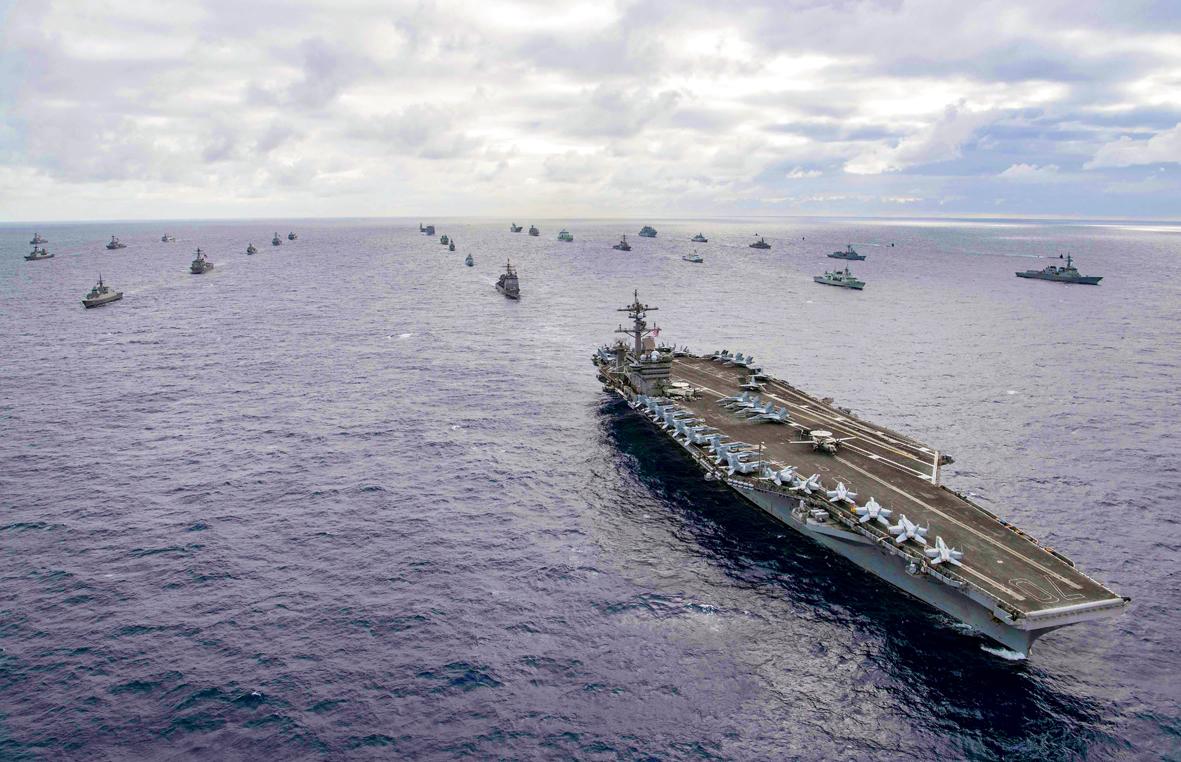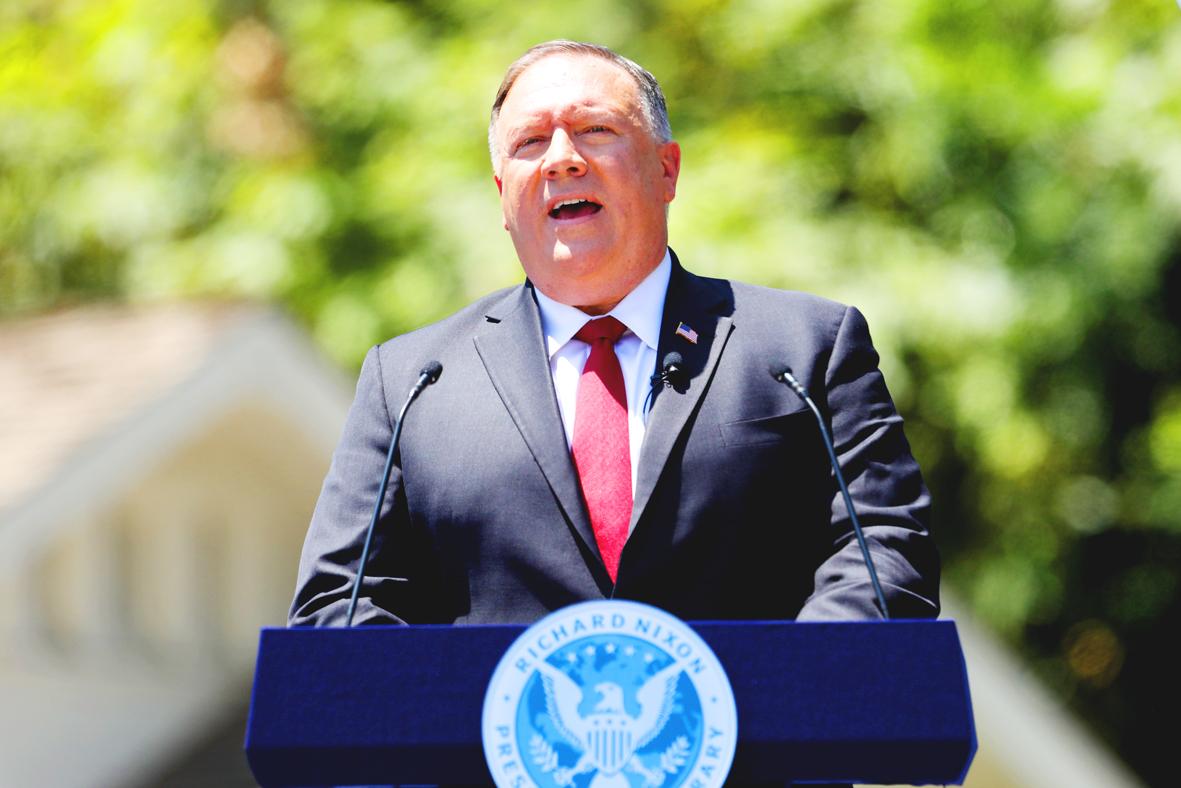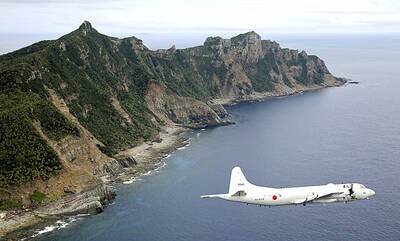The US Senate on Thursday passed its version of the US National Defense Authorization Act (NDAA) for next year, including provisions that support Taiwan’s participation in the Rim of the Pacific Exercise (RIMPAC), the world’s largest maritime warfare exercise, if appropriate.
The bill cleared the Senate floor in a 86-14 vote.
Provisions that include Taiwan are mentioned in sections 1258 and 1259 of the bill, which reiterates that the Taiwan Relations Act (TRA) and the “six assurances” provided by the US to Taiwan in July 1982 are “the foundation for United States-Taiwan relations.”

Photo: AFP / US NAVY / DYLAN M. KINEE
The “six assurances” were given by then-US president Ronald Reagan in 1982 and include pledges not to set a date for ending arms sales to Taiwan, not to hold prior consultations with China regarding arms sales to Taiwan, and not to be a mediator between Taiwan and China.
They also include assurances that the US will not revise the TRA or press Taiwan to enter into negotiations with China.
The NDAA also highlights US support for the development of Taiwan’s military, including through arms sales, exchanges between top defense officials and military exercises.

Photo: EPA-EFE
The exercises could include the RIMPAC, if appropriate, the NDAA says, although Taiwan has never participated before.
The NDAA also acknowledges China’s “increasingly coercive and aggressive behavior” toward Taiwan, contrary to the US’ expectation of a “peaceful resolution” of Taiwan’s future.
Citing the TRA, the NDAA says that the US would maintain the capacity “to resist any resort to force or other forms of coercion that would jeopardize the security, or the social or economic system, of the people on Taiwan, including the capacity of the United States armed forces to deny a ‘fait accompli’ operation by the People’s Republic of China to rapidly seize control of Taiwan.”
A section of the NDAA also advises the US Department of Defense to conduct port calls in Taiwan with two US naval hospital ships — the USNS Comfort and the USNS Mercy.
The port calls would allow “United States personnel to benefit from the expertise of Taiwanese personnel in light of the successful response of Taiwan to COVID-19” and would allow the two sides to continue collaborating on COVID-19 responses, the NDAA says.
The visits would also improve cooperation between the two sides in the areas of military medicine, humanitarian assistance and disaster relief, it said.
The US House of Representatives on July 21 passed its own version of the NDAA.
The two houses would soon begin negotiations to hammer out the differences in their competing bills before a final version can be signed into law by US President Donald Trump.
Separately on Thursday, US Secretary of State Mike Pompeo contrasted the responses of Taiwan and China to Washington’s policies.
“We opened our arms to Chinese citizens, only to see the Chinese Communist Party exploit our free and open society,” Pompeo said.
“We marginalized our friends in Taiwan, which later blossomed into a vigorous democracy,” he said.
Ministry of Foreign Affairs spokeswoman Joanne Ou (歐江安) yesterday thanked the US government for repeatedly voicing support for Taiwan publicly and urged other countries to face the threats posed by Beijing’s expansionism.
Whatever means China uses to squeeze Taiwan’s space in the global community, the government would never succumb to the pressure, Ou said in a statement, adding that the government would continue working with the US and other like-minded countries to defend democratic systems and a rule-based international order.
Ou also thanked the US Congress for continuing to promote Taiwan-US exchanges in military and security affairs.
The NDAA includes many provisions friendly to Taiwan, she said, adding that the ministry would monitor the bill’s development and maintain contact with US agencies to facilitate further Taiwan-US security cooperation.
Additional reporting by Lin Chia-nan

MISINFORMATION: The generated content tends to adopt China’s official stance, such as ‘Taiwan is currently governed by the Chinese central government,’ the NSB said Five China-developed artificial intelligence (AI) language models exhibit cybersecurity risks and content biases, an inspection conducted by the National Security Bureau (NSB) showed. The five AI tools are: DeepSeek, Doubao (豆包), Yiyan (文心一言), Tongyi (通義千問) and Yuanbao (騰訊元寶), the bureau said, advising people to remain vigilant to protect personal data privacy and corporate business secrets. The NSB said it, in accordance with the National Intelligence Services Act (國家情報工作法), has reviewed international cybersecurity reports and intelligence, and coordinated with the Ministry of Justice Investigation Bureau and the National Police Agency’s Criminal Investigation Bureau to conduct an inspection of China-made AI language

LIMITS: While China increases military pressure on Taiwan and expands its use of cognitive warfare, it is unwilling to target tech supply chains, the report said US and Taiwan military officials have warned that the Chinese People’s Liberation Army (PLA) could implement a blockade within “a matter of hours” and need only “minimal conversion time” prior to an attack on Taiwan, a report released on Tuesday by the US Senate’s China Economic and Security Review Commission said. “While there is no indication that China is planning an imminent attack, the United States and its allies and partners can no longer assume that a Taiwan contingency is a distant possibility for which they would have ample time to prepare,” it said. The commission made the comments in its annual

‘TROUBLEMAKER’: Most countries believe that it is China — rather than Taiwan — that is undermining regional peace and stability with its coercive tactics, the president said China should restrain itself and refrain from being a troublemaker that sabotages peace and stability in the Indo-Pacific region, President William Lai (賴清德) said yesterday. Lai made the remarks after China Coast Guard vessels sailed into disputed waters off the Senkaku Islands — known as the Diaoyutai Islands (釣魚台) in Taiwan — following a remark Japanese Prime Minister Sanae Takaichi made regarding Taiwan. Takaichi during a parliamentary session on Nov. 7 said that a “Taiwan contingency” involving a Chinese naval blockade could qualify as a “survival-threatening situation” for Japan, and trigger Tokyo’s deployment of its military for defense. Asked about the escalating tensions

DISPUTE: A Chinese official prompted a formal protest from Tokyo by saying that ‘the dirty head that sticks itself out must be cut off,’ after Takaichi’s Taiwan remarks Four armed China Coast Guard vessels yesterday morning sailed through disputed waters controlled by Japan, amid a diplomatic spat following Japanese Prime Minister Sanae Takaichi’s comments on Taiwan. The four ships sailed around the Senkaku Islands — known as the Diaoyutai Islands (釣魚台) to Taiwan, and which Taiwan and China also claim — on Saturday before entering Japanese waters yesterday and left, the Japan Coast Guard said. The China Coast Guard said in a statement that it carried out a “rights enforcement patrol” through the waters and that it was a lawful operation. As of the end of last month,